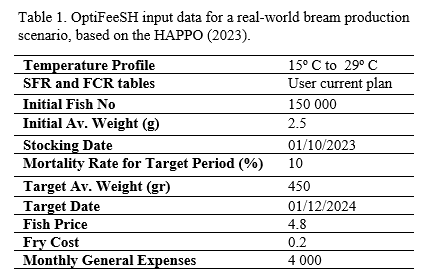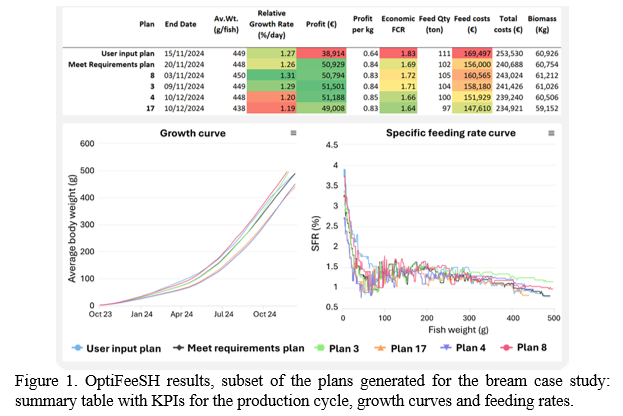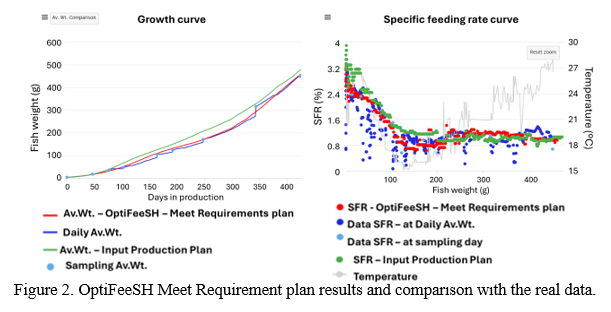OptiFeeSH PROJECT FOR OPTIMIZING FISH PRODUCTION PLANNING: A REAL-WORLD CASE STUDY
Introduction
Optimizing fish feeding is essential to minimize on-farm trial-and-error and robust production planning , enabling aquaculture stakeholders to make informed decisions. Despite increasing digitalization in the aquaculture space and scientific advances on fish nutrition , there is no solution for fish farmers that effectively addresses the major challenge of optimizing feeding planning in aquaculture: T he tools available so far do not integrate in-depth knowledge of fish nutrition. It is precisely this gap that OptiFeeSH project aims to fill by combining technical know-how in nutrition with digital intelligence, offering an innovative solution geared towards making informed and efficient decisions.
OptiFeeSH approach
The development of OptiFeeSH is driven by expertise in fish production and industrial R&D, integrating fish nutrition and farming technology within a user-friendly interface. Its Optimization module applies a biological approach based on a nutritional-based mathematical model, calibrated by species and sensitive to the feed energy and protein content. In a first step the system calculates four reference base plans:
- Maximum growth plan : feeding rates that ensure maximum growth.
- Lowest FCR plan : feeding rates that ensure the lowest FCR.
- Maximum profit plan : feeding rates that ensure the maximum profit.
- Meet requirements: fish feed requirements to ensure the user target weight.
In the second step, the engine creates interpolated plans, delivering a tailored set of feeding strategies aligned with the user’s specific production goals (Table 1).
Case study for a seabream cage farming
Herein, is illustrated a real-world seabream production scenario, targeting a fish weight of 450g after 14 months. The data input required is minimal and listed in Table 1.
Figure 1 shows a subset of the plans generated by OptiFeeSH for the bream case study (Table 1 ), which allows users to evaluate and choose according to their optimization targets: maximize profit, maximize growth, minimize FCR. All OptiFeeSH plans forecast improved profit and FCR compared to the current user plan (Figure 1) . The Meet Requirements Plan, designed to meet nutritional needs for the user input t arget weight and production period, aligns closely with real production data (Figure 2) and as shown in Figure 1, outperforms current user plans in both profit (€0.84 vs. €0.64 per kg biomass) and economic FCR (1.69 vs. 1.83) . Plan 8 delivers the fastest growth, while Plan 3 yields the highest profit for a 150,000-fish cage . Plan 3 provides a different feeding strategy, by increasing feeding rates for fish bigger than 250g, when comparing with the Meet Requirements , reaching the 450g target, 11 days earlier and increas ing the profit of the cage from 50.9k € to 51.5 k €. The subset of plans listed in Figure 1 also shows that a lower economic FCR does not always translate to higher profitability.
Conclusion
OptiFeeSH provides a sound scientific approach to create multiple production plans that meet each farm target growth and allows the user to choose the optimal one according to their criteria: faster growth, minimum FCR, maximum profit, or a compromised solution. These tailored feeding and production plans help avoid overfeeding, fine-tune FCRs, and detect underfeeding early, providing a solid basis for daily feeding decisions.
This work is part of the E!2498 OptiFeeSH project, No. 17506, Operation No. MPr-2023-4-17506 (COMPETE2030-FEDER-01004100, ALGARVE-FEDER-01004100), supported by the EUROSTARS-3 program and co-financed by the European Union through the Algarve 2030 and COMPETE 2030 Operational Programs, in the framework of Portugal 2030, RESTART 2016-2020 Programme (Cyprus), and Participation of Greece in two calls for proposals of the co-funded European Partnership for Innovative SMEs of Horizon Europe.


